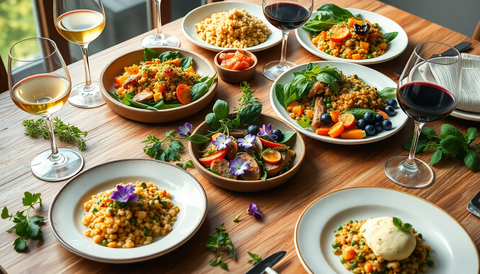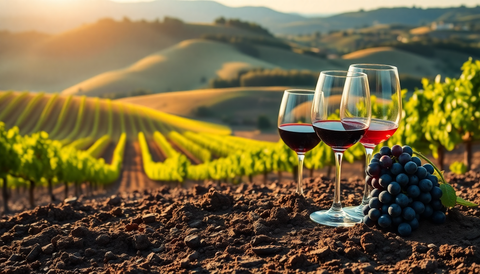Wine has captivated the human palate for millennia, with its complex flavors, aromas, and ability to enhance a meal or social gathering. But beyond the sheer enjoyment of drinking wine, there is a fascinating scientific story behind every bottle. From the intricate process of fermentation to the role of tannins and the influence of terroir, the science of wine is a rich tapestry that reveals the depth and nuance of this beloved beverage.
The Alchemy of Fermentation
At the heart of winemaking lies the process of fermentation, a transformation that has fascinated scientists and oenophiles alike. This ancient process, which has been practiced for thousands of years, is the result of a delicate dance between yeast and sugar.
When grapes are harvested and crushed, the natural sugars present in the fruit are exposed to the yeast that naturally occurs on the grape skins. These yeast cells, primarily Saccharomyces cerevisiae, begin to consume the sugars and convert them into alcohol and carbon dioxide through a series of complex biochemical reactions.
The specific strains of yeast used, as well as the environmental conditions during fermentation, can have a profound impact on the final flavor profile of the wine. Winemakers carefully monitor and manipulate factors such as temperature, oxygen levels, and nutrient availability to coax out the desired characteristics in the wine.
As the fermentation process progresses, the yeast cells convert the sugars into ethanol, which gradually increases in concentration until the yeast can no longer survive. This point, known as the "dry" stage, marks the completion of the primary fermentation, leaving behind a wine that is ready for further aging and refinement.
The Role of Tannins
Tannins, the astringent compounds found in wine, play a crucial role in shaping the overall character and mouthfeel of the final product. These polyphenolic molecules are derived from the grape skins, seeds, and stems, and their concentration and composition can vary greatly depending on the grape variety, growing conditions, and winemaking techniques.
During the winemaking process, tannins are extracted from the grape solids and incorporated into the wine. The level of tannin extraction is influenced by factors such as the duration of maceration (the time the grape must spends in contact with the skins and seeds), the temperature of fermentation, and the use of oak barrels during aging.
Tannins contribute to the wine's structure, providing a sense of weight and complexity on the palate. They also play a crucial role in the wine's ability to age, as the tannins interact with other compounds, such as anthocyanins, to form stable complexes that can evolve over time, resulting in the development of new flavors and aromas.
The perception of tannins can also be influenced by the wine's alcohol content, acidity, and the presence of other compounds, such as glycerol. Winemakers carefully balance these elements to create a harmonious and well-integrated tannic profile that enhances the overall drinking experience.
The Influence of Terroir
The concept of terroir, the unique combination of environmental factors that shape the character of a wine, is a fundamental aspect of the science behind wine. From the soil composition and climate to the topography and microclimates, each element of the terroir contributes to the distinctive flavors, aromas, and characteristics of the wine.
The soil, for instance, can impart specific mineral notes and influence the vine's ability to absorb nutrients and water. The climate, with its variations in temperature, rainfall, and sunlight, can affect the ripening process, the development of tannins, and the overall balance of the wine.
Winemakers meticulously study the terroir of their vineyards, often experimenting with different grape varieties, clones, and viticultural practices to extract the full potential of the land. This deep understanding of the terroir allows them to craft wines that are truly reflective of their place of origin, creating a sense of authenticity and uniqueness that captivates wine enthusiasts around the world.
The Art of Blending
While the science behind wine is fascinating, the art of blending is where winemakers truly showcase their skill and creativity. By carefully selecting and combining different grape varieties, vintages, and barrel lots, winemakers can create complex and harmonious blends that transcend the sum of their parts.
The process of blending involves a deep understanding of the individual characteristics of each component, as well as the ability to envision how they will interact and evolve when combined. Winemakers may blend different grape varieties to achieve a desired flavor profile, or they may blend wines from different vineyard sites to create a more nuanced and layered expression of the terroir.
The art of blending is not just about balancing flavors and aromas; it also involves considering the wine's structure, mouthfeel, and aging potential. Skilled winemakers can create blends that are greater than the individual parts, resulting in wines that are both intellectually and emotionally engaging.
The Endless Pursuit of Excellence
The science behind wine is a never-ending journey of discovery, with new insights and innovations constantly emerging. From the ongoing research into yeast strains and fermentation techniques to the exploration of novel grape varieties and the refinement of viticultural practices, the world of wine is a dynamic and ever-evolving field.
As wine enthusiasts, we are the beneficiaries of this relentless pursuit of excellence. With each sip, we are transported to the vineyards, the cellars, and the minds of the winemakers who have dedicated their lives to crafting the perfect bottle. The science behind wine is not just a means to an end, but a testament to the human desire to understand and harness the natural world, all in the service of creating a beverage that can bring joy, contemplation, and a deeper appreciation for the world around us.
So, the next time you savor a glass of wine, take a moment to reflect on the intricate dance of science and art that went into its creation. For in that moment, you are not just drinking a glass of wine, but experiencing the culmination of centuries of human ingenuity, passion, and a deep respect for the natural world.




Comments (0)
There are no comments for this article. Be the first one to leave a message!